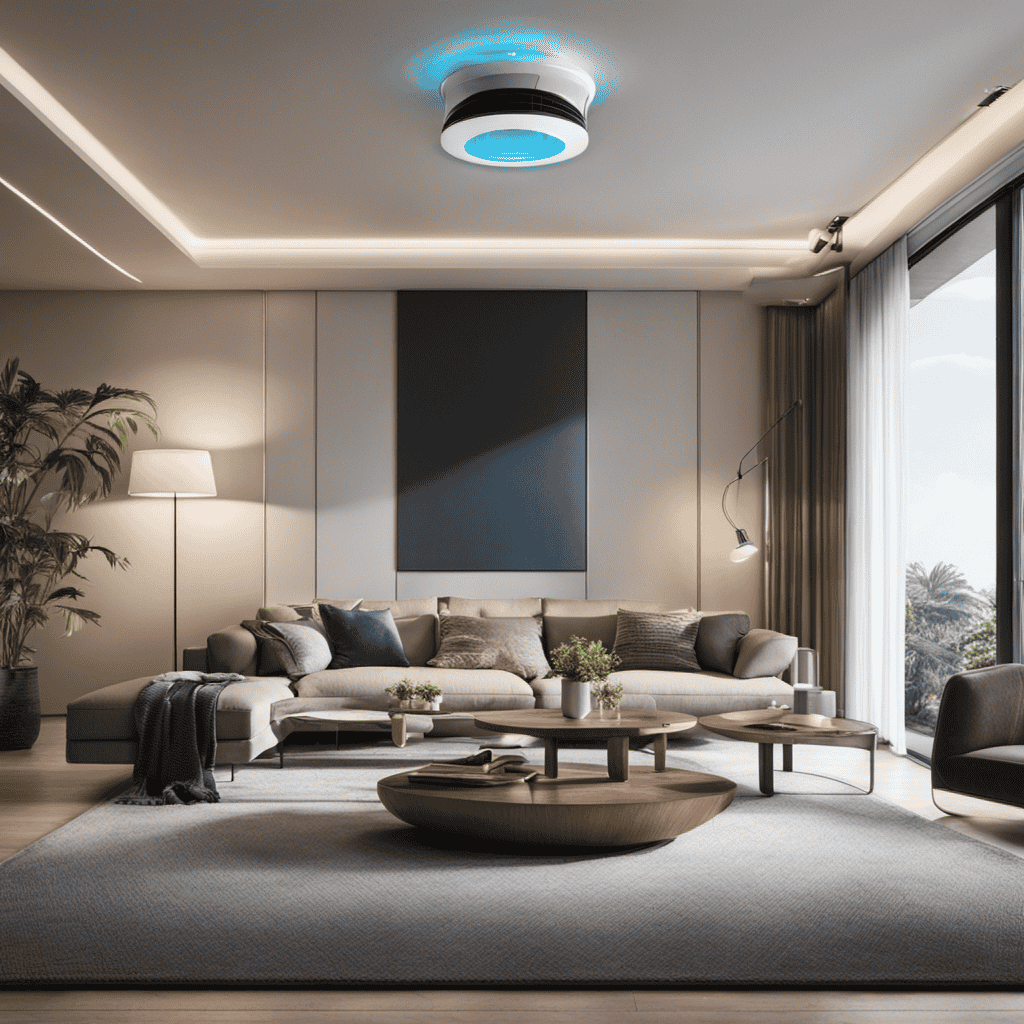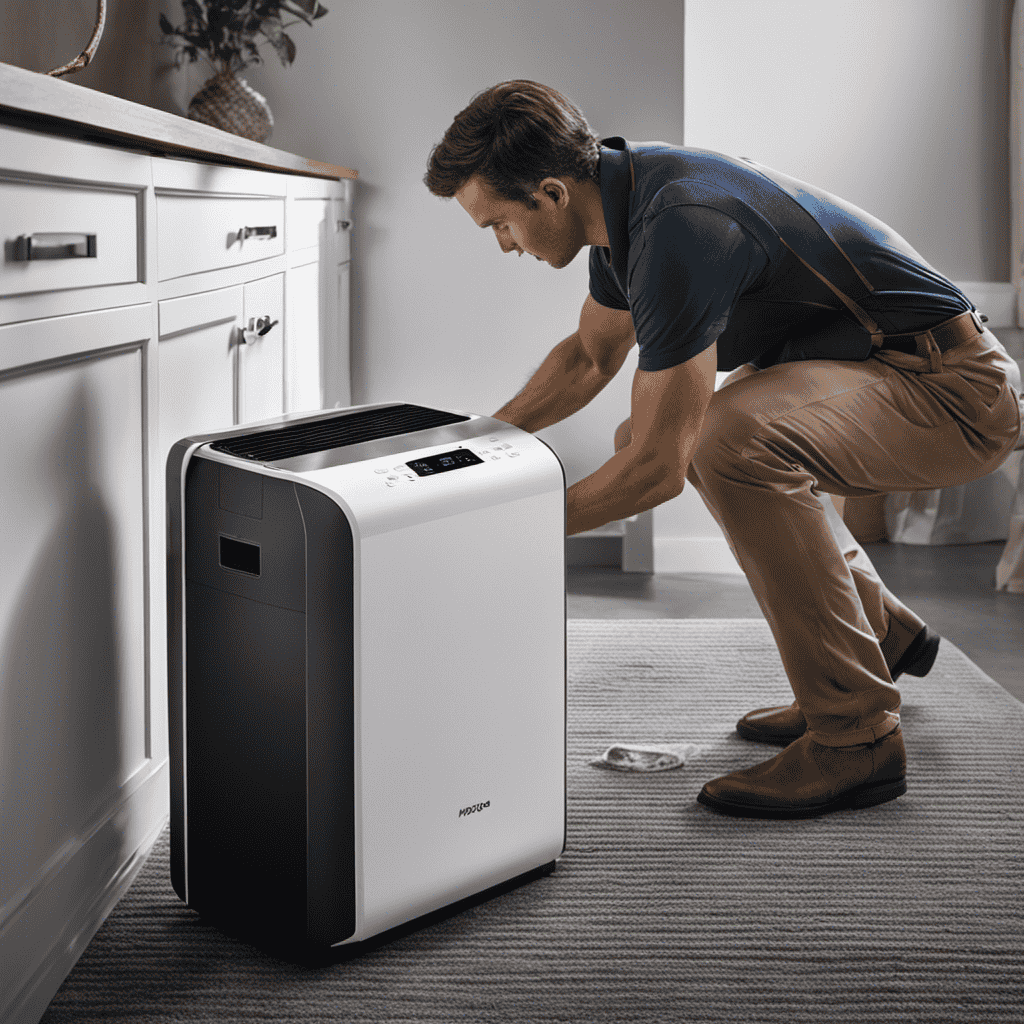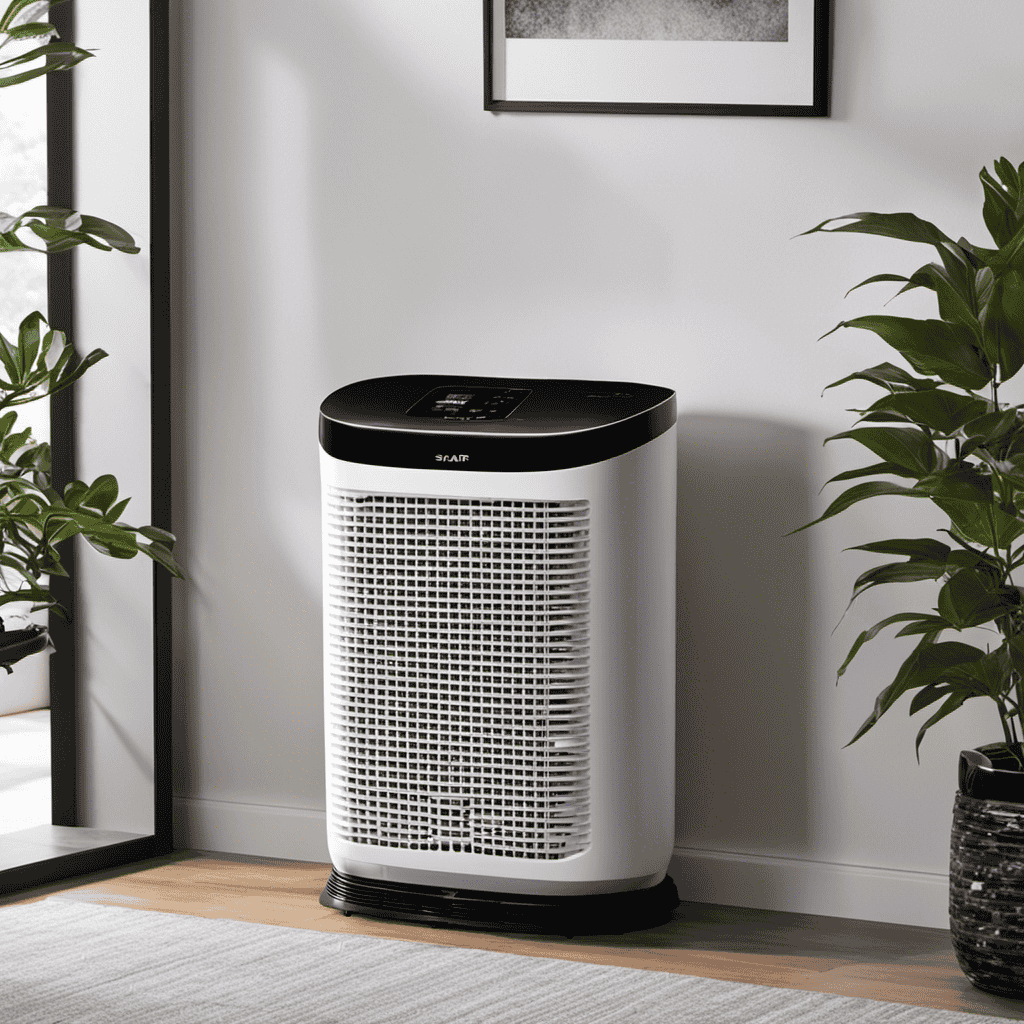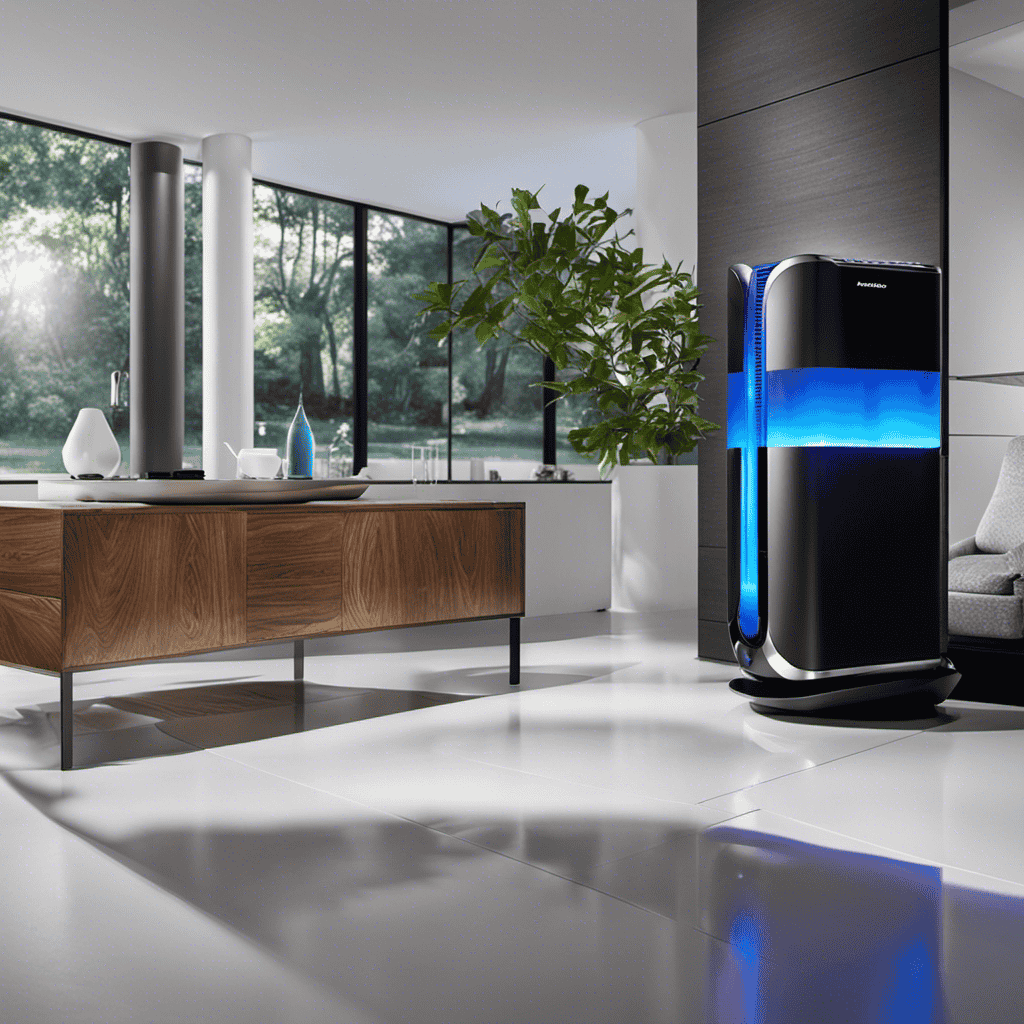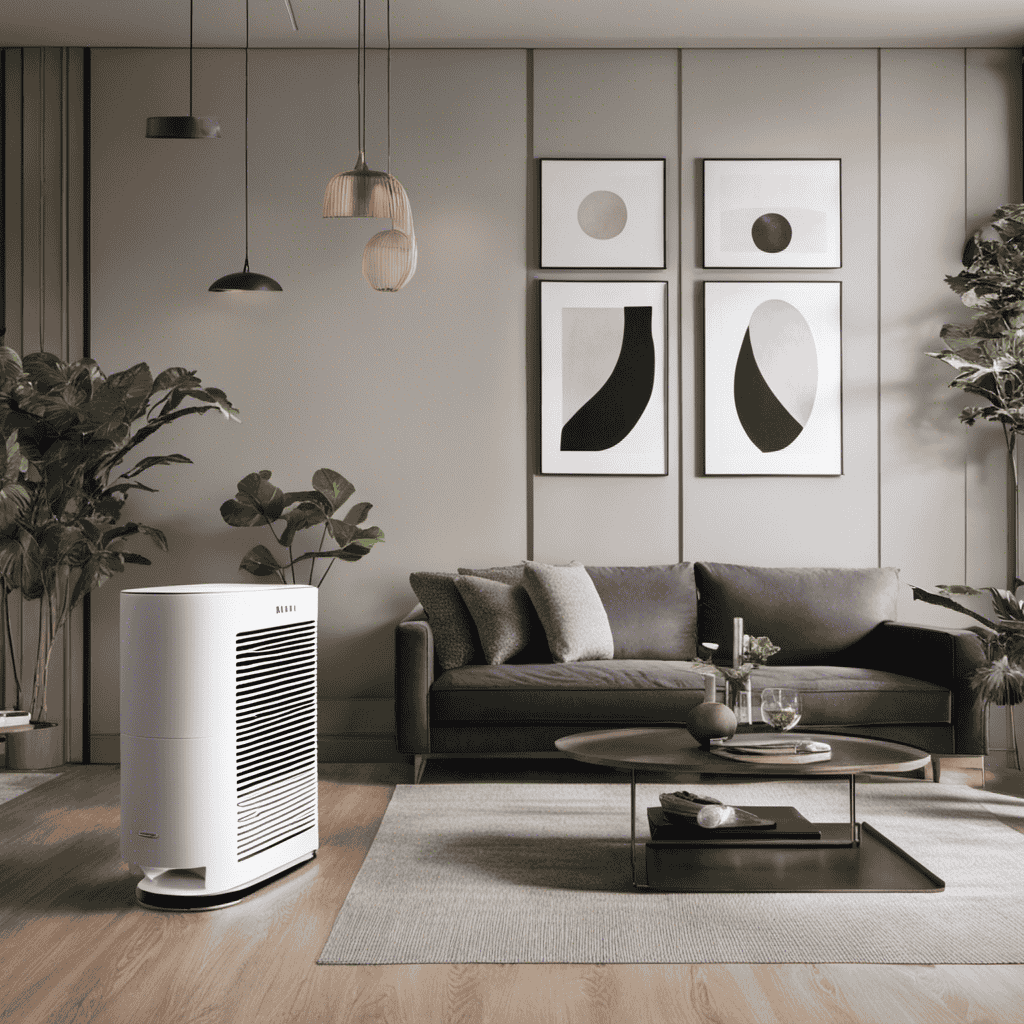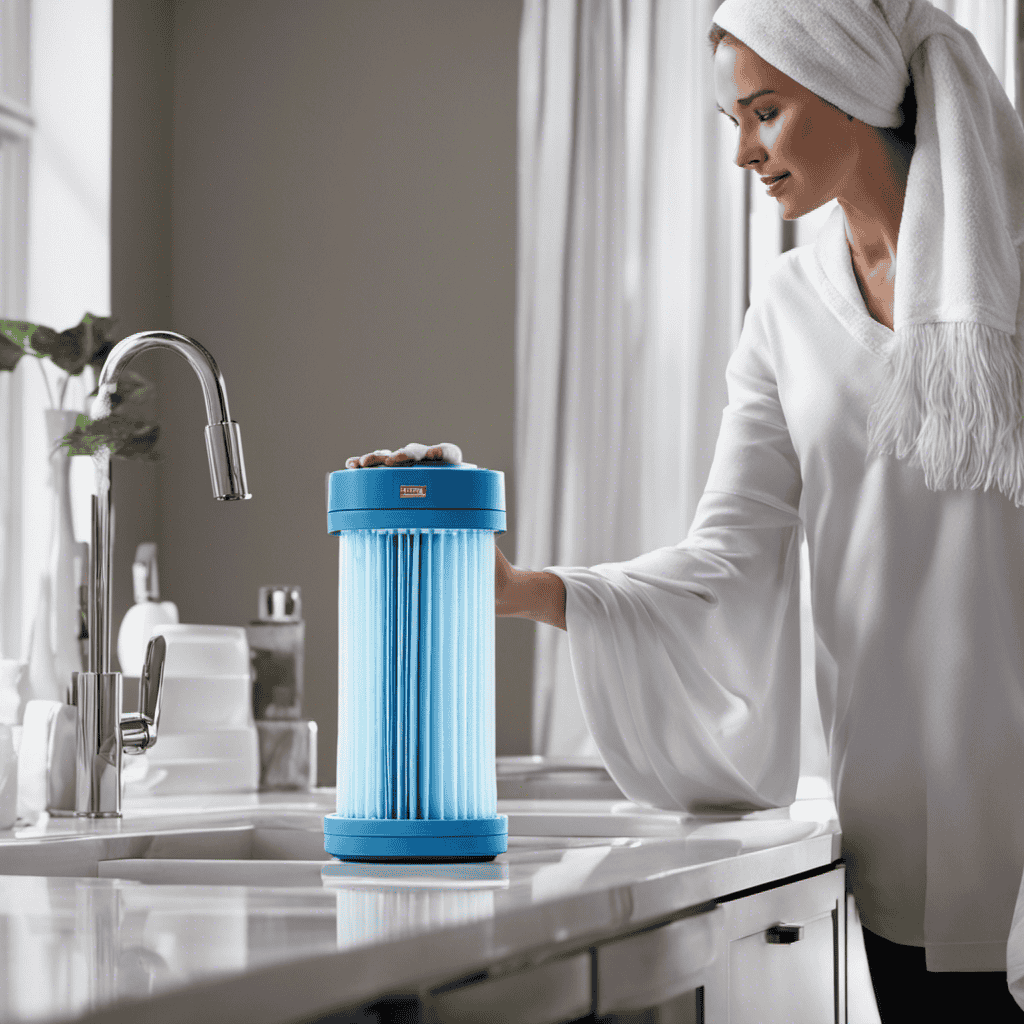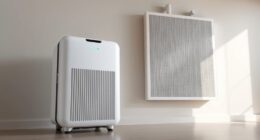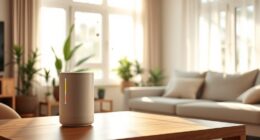Regarding the purchase of an air purifier, myriad choices are available.
But did you know that indoor air can be up to five times more polluted than outdoor air? That’s why it’s crucial to consider the right factors before making a purchase.
In this article, I’ll guide you through the key considerations, including cost, size, filtration systems, capacity, noise levels, and additional features.
By the end, you’ll have the knowledge to find the perfect air purifier for your needs.
Key Takeaways
- Consider energy efficiency and maintenance costs, including filter replacements, when buying an air purifier.
- Look for compact and portable air purifiers that save space and are easy to transport.
- Choose the appropriate filtration system based on your specific needs and air quality issues.
- Take into account the purification capacity, coverage area, noise levels, and operating modes of the air purifier.
Cost and Budget Considerations
When buying an air purifier, you should consider how much you’re willing to spend and what your budget allows for.
Two important factors to consider are energy efficiency and maintenance costs. Energy efficiency refers to how much electricity the air purifier consumes while operating. Look for models that have an Energy Star rating, as they are designed to use less energy and can help you save on your electricity bill.
Additionally, consider the maintenance costs associated with the air purifier. Some models may require frequent filter replacements, which can add up over time. Look for air purifiers with washable and reusable filters, as they can help reduce long-term maintenance costs.
Considering both energy efficiency and maintenance costs will ensure that you make an informed decision when purchasing an air purifier.
Size and Portability
To ensure the right fit for your space, take into account the size and portability of the air purifier you’re looking to purchase. When choosing an air purifier, it is important to consider the dimensions of the unit and whether it can easily be moved around. Here are some key factors to consider:
- Space-saving design: Look for compact air purifiers that can fit seamlessly into your room without taking up too much space.
- Portability: Opt for air purifiers with wheels or handles for easy transportation from one room to another.
- Lightweight construction: Consider lightweight models that can be effortlessly carried up and down stairs or between different floors.
By carefully considering the size and portability of an air purifier, you can ensure that it will be a convenient addition to your home.
Additionally, choosing a compact and portable unit will make air purifier maintenance and cleaning tasks easier. Furthermore, energy efficiency is crucial when selecting an air purifier to minimize electricity consumption and reduce your carbon footprint.
Types of Filtration Systems
If you want to improve the air quality in your home, consider the different types of filtration systems available.
When it comes to air purifiers, two popular types of filtration systems are HEPA and carbon filtration. HEPA (High Efficiency Particulate Air) filters are designed to capture small particles such as dust, pollen, and pet dander. They are highly effective at removing airborne allergens and pollutants.
On the other hand, carbon filters are great for removing odors, chemicals, and volatile organic compounds (VOCs) from the air.
Another consideration when choosing an air purifier is the type of technology used for air sanitization. UV (Ultraviolet) light is effective at killing bacteria and viruses, while ionization creates negative ions that attach to airborne particles, making them fall to the ground.
It’s important to consider your specific needs and the air quality issues in your home before selecting the right filtration system for you.
Air Purification Capacity and Coverage Area
When it comes to choosing an air purifier, understanding its purification capacity is crucial. The purification capacity refers to the amount of air that the purifier can effectively clean within a given timeframe.
Additionally, it’s important to consider the area coverage of the purifier, as this determines how well it can clean the air in a specific room or space.
Lastly, matching the size and needs of the air purifier to your requirements is essential for optimal performance and efficiency.
Purification Capacity Explained
Consider how large of a space you need the air purifier to clean, as this will determine the purification capacity you should look for. The purification capacity of an air purifier is measured in terms of the air changes per hour (ACH). This refers to the number of times the air in a room can be completely cleaned within an hour.
When choosing an air purifier, it’s important to consider its maintenance requirements and energy efficiency. Maintenance requirements can include things like replacing filters regularly and cleaning the unit. Energy efficiency is important for reducing electricity consumption and keeping your energy bills low.
Taking these factors into account will help you choose an air purifier that is effective, easy to maintain, and energy-efficient.
Now, let’s move on to discussing area coverage considerations.
Area Coverage Considerations
To determine the appropriate air purifier for your space, you’ll want to assess the size of the area you need to cover.
It is important to consider air quality standards and maintenance requirements when selecting an air purifier. Air quality standards vary depending on the region and specific needs of individuals. Understanding the air quality standards in your area will help you choose an air purifier that effectively removes pollutants and allergens.
Maintenance requirements should also be taken into account. Some air purifiers require regular filter changes, while others have washable filters.
Additionally, consider the noise level of the air purifier and whether it fits within your desired aesthetic.
Matching Size and Needs
When it comes to buying an air purifier, it’s important to consider the size of the unit and your specific needs. A purifier that is too small won’t effectively clean the air in your space, while one that is too large may waste energy and cost more to operate. Matching the size of the air purifier to the square footage of your room is crucial for optimal performance and energy efficiency.
Additionally, you should consider your specific needs and any unique requirements you may have. Some air purifiers are designed to target specific pollutants like allergens or odors, while others offer features like UV-C light or ionizers.
Finally, maintenance requirements should also be taken into account, as regular filter replacements and cleaning can impact the long-term cost and effectiveness of the unit.
A smaller air purifier may seem like a budget-friendly option, but it can lead to inadequate air purification and potential health risks. Investing in an appropriately sized air purifier not only ensures efficient air cleaning but also helps in reducing energy consumption and lowering utility bills. Opting for an air purifier with specific features to address your needs, such as an activated carbon filter for odor control, can greatly enhance your indoor air quality and overall comfort.
Noise Levels and Operating Modes
The noise levels and operating modes are important factors to look at when buying an air purifier.
When it comes to noise levels, you want an air purifier that operates silently, especially if you plan to use it in your bedroom or office. Look for models that have a ‘silent operation’ feature or mention low decibel levels in their specifications. This ensures that the air purifier won’t disturb your sleep or concentration.
Another important feature to consider is the operating modes. Many air purifiers come with an automatic mode, which adjusts the fan speed and filtration settings based on the air quality in the room. This mode is convenient as it takes away the need for constant manual adjustments, ensuring optimal performance without any hassle.
Additional Features and Smart Capabilities
When it comes to smart technology benefits and essential additional features in air purifiers, there are a few key points to consider.
Firstly, smart technology allows for remote control and monitoring, giving you the convenience of adjusting settings and checking air quality from anywhere.
Secondly, essential additional features such as air quality sensors and automatic mode adjustment can greatly improve the effectiveness of the purifier in maintaining clean air.
Lastly, features like filter replacement indicators and energy-saving modes are important considerations for long-term usability and efficiency.
Smart Technology Benefits
One of the benefits of smart technology in air purifiers is that they can be controlled remotely using a smartphone. This smart technology integration allows users to conveniently monitor and adjust the air purifier from anywhere, providing a seamless user experience.
With air quality monitoring capabilities, the air purifier can automatically detect and measure pollutants in the air, providing real-time data on the indoor air quality. This feature ensures that you are always aware of the air you breathe and can take necessary actions to improve it.
Additionally, smart technology integration allows for scheduling and personalized settings, ensuring that the air purifier operates efficiently based on your preferences and needs. This level of control and convenience not only enhances the overall user experience but also contributes to a healthier living environment.
Essential Additional Features
To enhance your experience, you can also explore air purifiers with built-in humidifiers for added moisture in your home. These essential additional features not only purify the air but also help maintain an optimal humidity level, which is crucial for your health and comfort. When considering an air purifier with a built-in humidifier, it is important to look for certain features such as air quality indicators and filter replacement notifications. The air quality indicators provide real-time feedback on the air quality in your home, allowing you to make informed decisions about when to adjust the settings. Filter replacement notifications ensure that you never forget to change the filters, which is essential for the optimal performance of the air purifier. Investing in an air purifier with these additional features can greatly improve the air quality in your home and enhance your overall well-being.
| Features | Benefits |
|---|---|
| Air Quality Indicators | Real-time feedback on air quality |
| Filter Replacement Notifications | Ensures optimal performance |
| Built-in Humidifier | Maintains optimal humidity level |
Frequently Asked Questions
How Often Do I Need to Replace the Filters in an Air Purifier?
When it comes to air purifiers, one important factor to consider is the filter replacement frequency. Different brands may have varying recommendations, so it’s best to check the manufacturer’s guidelines for the specific model you’re interested in.
Can an Air Purifier Remove Odors From My Home?
An air purifier can effectively remove various types of odors from your home. It uses filters or other technologies to capture and neutralize odor-causing particles, improving the overall air quality in your living space.
Are There Any Potential Health Risks Associated With Using an Air Purifier?
There are potential side effects and long-term effects associated with using an air purifier. It is important to consider these health risks before making a purchase.
Can an Air Purifier Help With Allergies and Asthma?
An air purifier can be effective in reducing respiratory symptoms for those with allergies and asthma. When choosing one, compare models specifically designed for allergy and asthma relief.
Do Air Purifiers Use a Lot of Electricity?
When considering air purifiers, it’s important to think about energy consumption. Some models use more electricity than others, so finding one that offers cost efficiency while still effectively purifying the air is crucial.
Conclusion
In conclusion, when purchasing an air purifier, it is crucial to consider various factors to make an informed decision.
Factors such as cost, size, and filtration systems are essential to ensure the purifier meets your specific needs and budget.
Additionally, assessing the air purification capacity and coverage area, noise levels, and operating modes will help determine its suitability for your environment.
Lastly, exploring additional features and smart capabilities can enhance the overall user experience.
By carefully considering these factors, you can select an air purifier that will efficiently improve your indoor air quality and create a healthier living environment.
